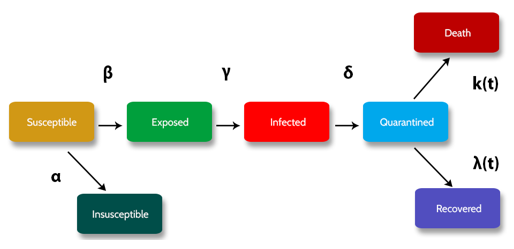Implementation of Hybrid Prediction Model: An Unsupervised and Supervised Learning Perspective
Main Article Content
Abstract
Using raw data to make inferences is the core of data science. This might be accomplished by closely examining the complex trends and patterns in the data. Machine Learning based forecasting methods have shown useful in predicting perioperative outcomes to improve the quality of future event planning decisions. In many application sectors where machine learning models were used, it has long been necessary to identify and prioritise the negative characteristics of a threat. Wish to provide precise predictions about a certain set of data, for example, use machine learning techniques in data science. Numerous prediction algorithms are now in use to address forecasting issues. Numerous epidemiological models are being employed internationally to forecast pandemic mortality rates and the number of affected people. Making the right decisions depends on the development of reliable prediction models.
Epidemiological models have had trouble making longer-term forecasts with a higher degree of accuracy due to a lack of significant data and ambiguity. This research suggests a hybrid machine learning approach to anticipate the pandemic in contrast to Susceptible-Infected-Resistant based models, and we demonstrate its potential using COVID-19 data from India. Order to improve the identification of epidemics early, The model can also be updated using data from sources like search engine searches. Results from two well-known machine learning methods were compared to those from the improved SIR and SEIQR models.
Article Details
References
Jin, Weiqiu, et al. "A data-driven hybrid ensemble AI model for COVID-19 infection forecast using multiple neural networks and reinforced learning." Computers in Biology and Medicine 146 (2022): 105560.
Azar, Ahmad Taher, and Aboul Ella Hassanien, eds. Modeling, control and drug development for COVID-19 outbreak prevention. Springer, 2022.
Rahimi, Iman, et al. "Analysis and prediction of COVID-19 Using SIR, SEIQR, and machine learning models: Australia, Italy, and UK Cases." Information 12.3 (2021): 109.
Kamiri, Jackson, and Geoffrey Mariga. "Research methods in machine learning: A content analysis." International Journal of Computer and Information Technology (2279-0764) 10.2 (2021).
Bayat, Sayeh, et al. "Identifying preclinical Alzheimer disease from driving patterns: a machine learning approach." Alzheimer's & Dementia 17 (2021): e057316.
Rinaldi, Gianmario, et al. "Epidemiological model based periodic intervention policies for COVID-19 mitigation in the United Kingdom." Scientific Reports 12.1 (2022): 1-17.
Huang, Guangqiu. "Artificial infectious disease optimization: A SEIQR epidemic dynamic model-based function optimization algorithm." Swarm and evolutionary computation 27 (2016): 31-67.
Aràndiga, Francesc, et al. "A spatial-temporal model for the evolution of the COVID-19 pandemic in Spain including mobility." Mathematics 8.10 (2020): 1677.
Fields, R., et al. "Age-stratified transmission model of COVID-19 in Ontario with human mobility during pandemic's first wave." Heliyon 7.9 (2021): e07905.
Varanasi, Venkata Ramani, and Shaik Razia. "Intrusion detection using machine learning and deep learning." Int J Recent Technol Eng (2019).
Kardani, Navid, et al. "Modelling of municipal solid waste gasification using an optimised ensemble soft computing model." Fuel 289 (2021): 119903.
Varanasi, Venkata Ramani, and Shaik Razia. "Intrusion detection using machine learning and deep learning." Int J Recent Technol Eng (2019).
Dutta, Krittika, et al. "A data mining based target regression-oriented approach to modelling of health insurance claims." 2021 5th International Conference on Computing Methodologies and Communication (ICCMC). IEEE, 2021.
Baig, Mirza Ghazanfar, and Sandeep Kumar Nayak. "Critical analysis on data science and big data avenues." International Journal of Scientific and Technology Research 8.11 (2019).
Shadabfar, Mahdi, et al. "Time-variant reliability-based prediction of COVID-19 spread using extended SEIVR model and Monte Carlo sampling." Results in Physics 26 (2021): 104364.
Pinter, Gergo, et al. "COVID-19 pandemic prediction for Hungary; a hybrid machine learning approach." Mathematics 8.6 (2020): 890.
Gudigar, Anjan, et al. "Role of artificial intelligence in COVID-19 detection." Sensors 21.23 (2021): 8045.
Jamshidi, Mohammad, et al. "Artificial intelligence and COVID-19: deep learning approaches for diagnosis and treatment." Ieee Access 8 (2020): 109581-109595.
Baig, Mirza Ghazanfar, and Sandeep Kumar Nayak. "Machine Intelligence in COVID-19 Prediction: An Adaptable Approach For Automation.” International Journal of Mechanical Engineering Vol. 6 No. 2 : 2021
Vega, Roberto, Leonardo Flores, and Russell Greiner. "SIMLR: Machine Learning inside the SIR model for COVID-19 Forecasting." Forecasting 4.1 (2022): 72-94.
Khaloofi, Huda, et al. "Performance evaluation of machine learning approaches for covid-19 forecasting by infectious disease modeling." 2021 International Conference of Women in Data Science at Taif University (WiDSTaif). IEEE, 2021.
Agarwal, Praveen, et al., eds. Analysis of infectious disease problems (Covid-19) and their global impact. Singapore: Springer, 2021.

